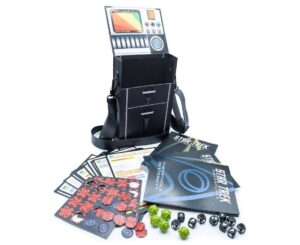
 Star Trek Adventures offers many different formats for Game Masters to choose from. There are: campaigns, standalone missions, mission briefs and plot hooks.
Star Trek Adventures offers many different formats for Game Masters to choose from. There are: campaigns, standalone missions, mission briefs and plot hooks.
The campaign is the major goal for a Game Master. Requiring hours of prep, many sessions to run and multiple plot lines to keep track of, the campaign is best suited for the experienced Game Master, who has several standalone missions under her belt.
The campaigns tell a broad story that centers on the PCs’ crew. Too often it can be easy to lose sight that the story is about the PCs’ characters and not about all the cool things the writers put into the campaign. The events in the campaign book are the events the PCs wind up being involved with and bringing closure to. The events alone should not eclipse the actions of the PCs.
There are several campaign guides for Star Trek Adventures. A sandbox-style campaign based on exploration can be found with the Shackleton Expanse Campaign Guide. Explore uncharted space in a region located near the borders of the Federation, Romulan and Klingon Empires. Recently, Modiphius released the Discovery Campaign Guide.
Modiphius frequently releases standalone modules. These shortform, often single-session adventures are generally tailored to a specific era, such as The Original Series or The Next Generation. These adventures are good for a night’s worth of gaming, with no social contract for a prolonged campaign. The standalones can also be inserted into a campaign to provide a break from the main story.
One of the more recent adventures is written by the prolific Christopher L. Bennett. Titled Better Days, it tells the story of a Federation crew that journeys into the Bajor wormhole to explore the Gamma Quadrant, when things go wrong. The crew needs to back out of the wormhole… only to discover they’ve traveled two hundred years into the past. There’s no Deep Space Nine to hail.
The crew needs to travel to Bajor undercover and repair their ship. They experience a Bajor that hasn’t known the suffering of the Cardassian occupation. The crew must resist the urge to warn the Bajorans about what their future holds.
Next, there are mission briefs. Mission briefs fill the same role as standalone missions. They’re great for one-shot games, like for conventions or social gatherings. They can also be used to flesh out existing campaigns. The mission briefs offer about ten outlines for adventures, offering the same basic structure: synopsis, major beats, minor beats, and conclusion. They also include tips on how to work the adventure into an existing campaign.
A great feature of the mission briefs is they tell what crew role the adventure is meant to put into the spotlight. If your Chief Medical Officer hasn’t had much to do in the last couple of adventures, consult mission briefs and look for one that says: Spotlight: Medical Officer. It saves the Game Master from having to put together a specialized adventure from the ground up for that character.
A recent collection of mission briefs offers encounters involving psychic incursions. In an adventure spotlighting the CMO, the crew investigates a dust cloud around a “planetary super collision.” After leaving the scene, the crew begins to act impulsively, as if they’re under the influence of alcohol. The CMO needs to lead the crew to find a cure, while the crew tries to keep themselves under control.
Finally, there are plot hooks. Plot hooks can be found in every book in the Star Trek Adventures line. They are one or two sentence-long statements of what happens in the story. It’s up to the Game Master to flesh everything out and make a full-fledged story of it.
The best plot hooks can be found by perusing the PCs’ character sheets. Look at the different Lifepath Events that went into the building of the character. Most steps include events that happened that made the characters the people they are today. Bringing back characters from a PCs’ past is a great way to show appreciation for the effort the players put into creating their own characters.
From campaigns to plot hooks, there are a wide variety of resources available for Game Masters to find inspiration for stories their groups will remember for years to come.
